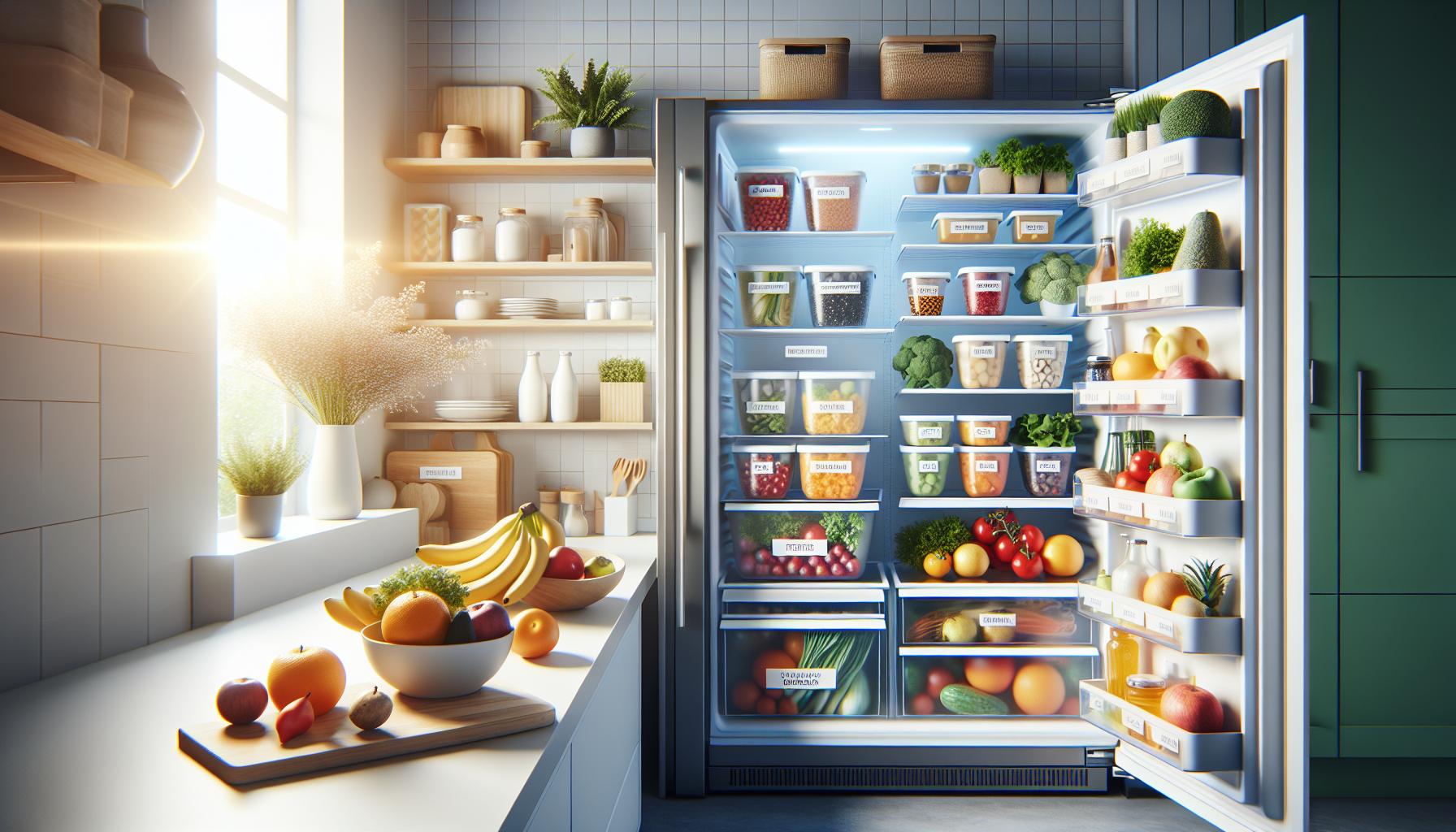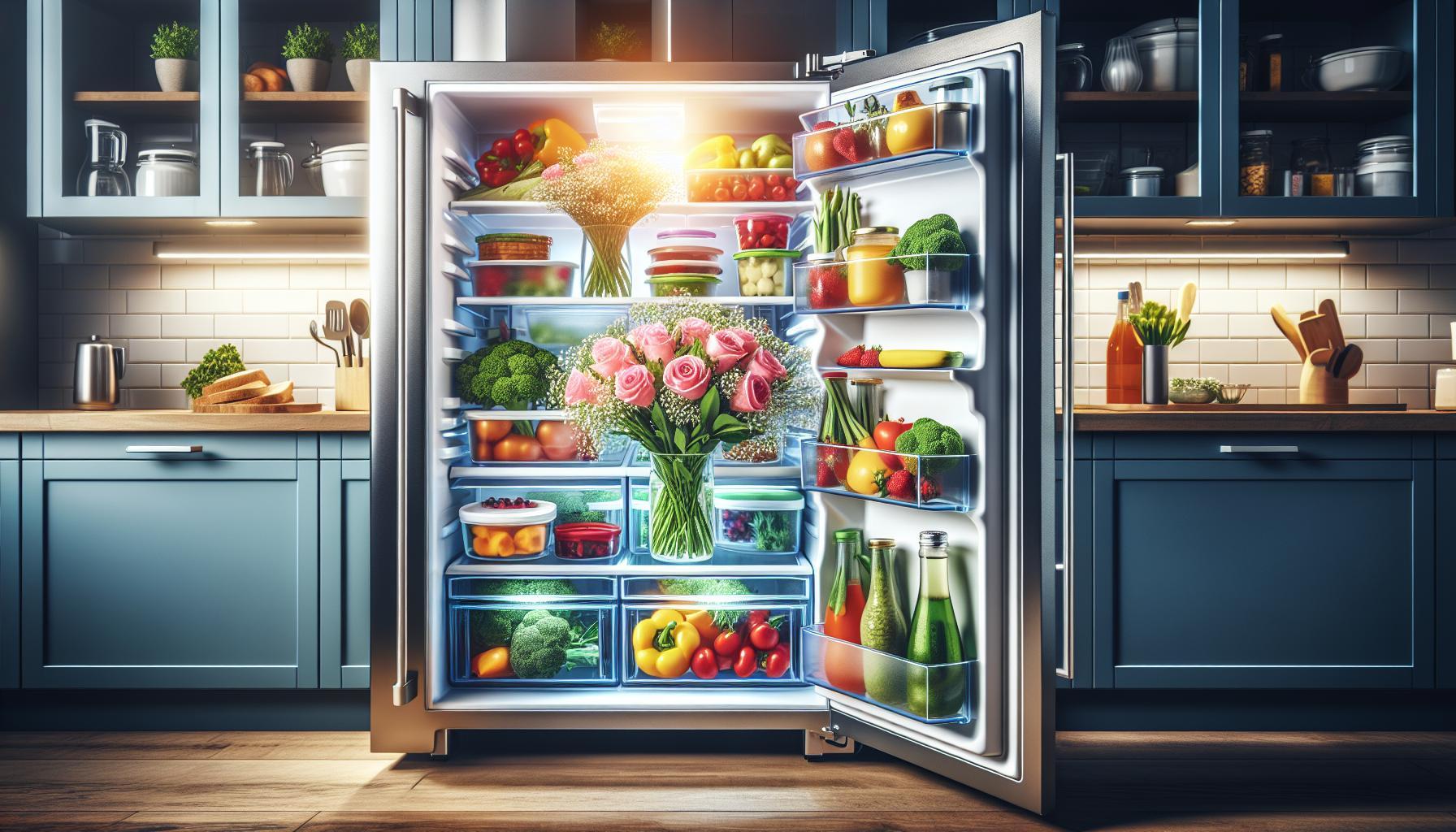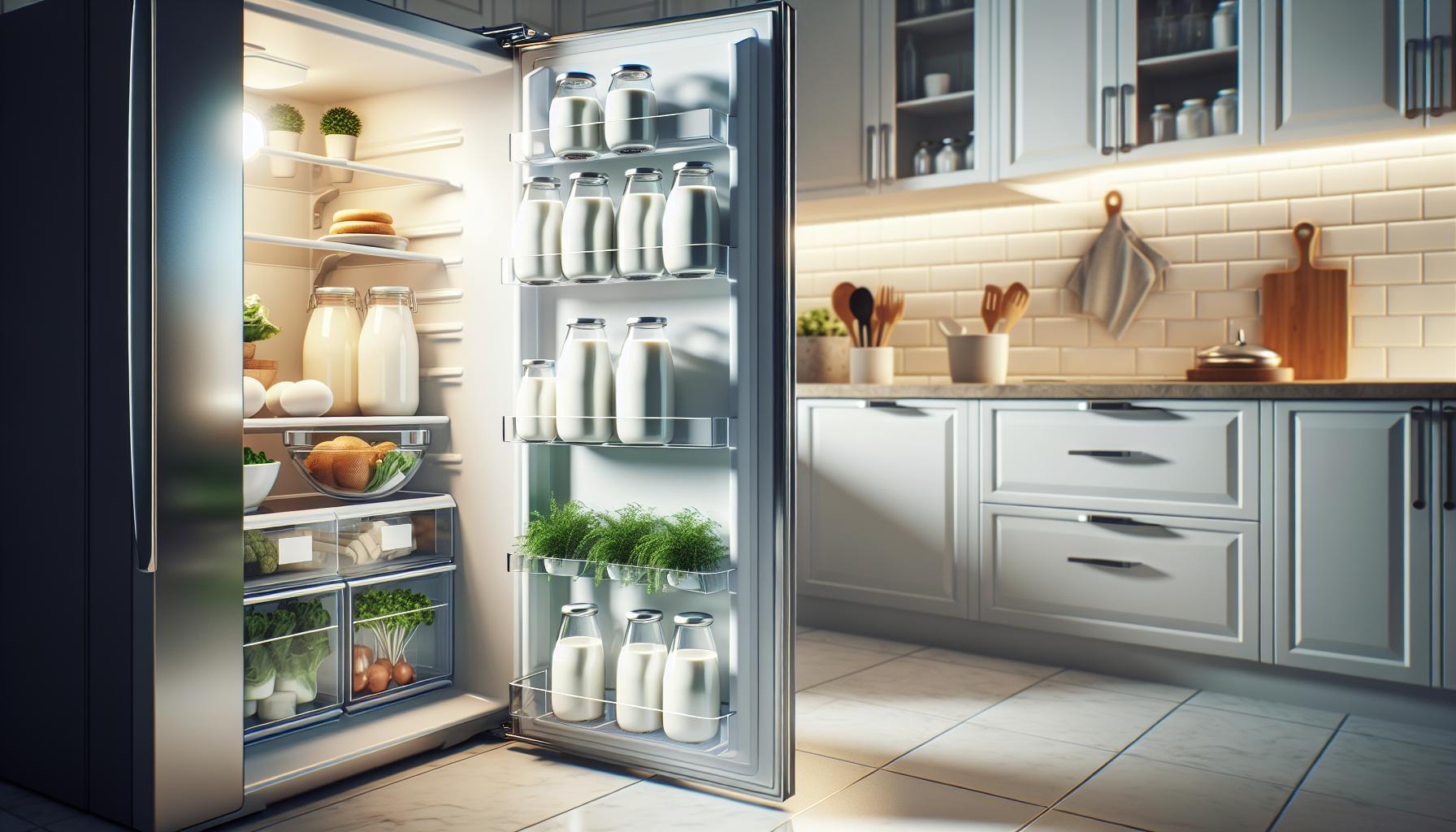Did you know that keeping flowers in the fridge can significantly extend their life and vibrancy? Fresh blooms, while stunning, can quickly wilt without proper care. Understanding how long flowers last in the fridge, along with the right techniques for storing them, can transform your floral arrangements from fleeting beauty to prolonged enjoyment.
For anyone looking to preserve their bouquet’s freshness and charm, this guide will reveal essential tips and science-backed practices. Whether you’re preparing for a special occasion or simply want to make your floral gifts last longer, learning to properly store your flowers can yield remarkable results. Let’s dive into the best methods for optimizing your flowers’ lifespan in the fridge, ensuring they stay beautiful for days to come.
How Long Can You Store Flowers in the Fridge?
Storing flowers in the refrigerator can significantly extend their freshness, but how long can you actually keep them there? Generally, most cut flowers can be stored in the fridge for about 3 to 7 days, depending on the type of flower and its current condition. Cold temperatures slow down the metabolic processes that lead to wilting, making the fridge a great temporary haven for your blooms. However, not all flowers respond the same way to refrigeration, and careful handling is key to maximizing their lifespan.
To optimize this storage method, make sure to prepare the flowers properly before placing them in the fridge. Remove any leaves that will be submerged in water, as these can encourage bacterial growth. Place the flowers in a clean vase with fresh water, ideally mixed with a floral preservative to provide essential nutrients. For best results, keep the fridge temperature between 34°F and 36°F (1°C to 2°C) and avoid abrupt temperature changes, as this can upset delicate blooms. It’s also a good idea to keep flowers away from fruits and vegetables, which release ethylene gas that can speed up the aging process of flowers.
If you follow these practices, your flowers can thrive in the cool environment of your refrigerator. However, it’s vital to check them daily for any signs of wilting or deterioration, which may require adjustments or prompt consumption to enjoy their beauty fully. Remember that the goal is not just to prolong life, but to maintain the stunning vibrancy that makes flowers so enchanting in the first place.
The Science Behind Flower Lifespan

The longevity of cut flowers is highly influenced by the biological processes that occur once they are separated from their root system. After being cut, flowers begin to experience a decline in health due to reduced water and nutrient uptake, which ultimately leads to wilting. Temperature plays a pivotal role in these processes; keeping cut flowers in a cool environment, such as a refrigerator, slows down their metabolism and extends their display life. Typically, flowers stored in the fridge can last between 3 to 7 days, depending on their type and condition at the time of refrigeration.
When flowers are placed in the fridge, several physiological changes are occurring. The cold inhibits the production of ethylene, a gas released by fruits that hastens ripening and aging in plants, thus slowing down the natural aging process of the flowers. Additionally, lower temperatures reduce the activity of enzymes and microorganisms that can contribute to spoilage. For optimal preservation, it’s essential to maintain fridge temperatures between 34°F and 36°F (1°C to 2°C), as fluctuations can stress the delicate petals and foliage.
To further enhance the lifespan of your flowers in refrigeration, it’s crucial to prepare them correctly beforehand. This includes hydrating them properly by using fresh water mixed with a floral preservative, which contains sugar to nourish the flowers and biocides to combat bacterial growth. Moreover, removing any foliage submerged in water can prevent the proliferation of bacteria, which is vital for maintaining freshness. Regular monitoring is also key; check flowers daily for any signs of wilting or decay, enabling you to take swift action if needed. By understanding and managing the science behind flower longevity, you can enjoy beautiful, vibrant blooms for an extended period.
Ideal Conditions for Maintaining Freshness

Keeping flowers fresh in a refrigerator can significantly prolong their beauty and vibrancy, but it requires attentiveness to specific conditions. The ideal storage environment combines optimal temperature, humidity, and minimal exposure to ethylene gas, ensuring that your blooms remain as lively as when they were first cut. To achieve this, set your refrigerator temperature between 34°F and 36°F (1°C to 2°C). Not only does this cool setting slow down the flowers’ metabolic processes and delay wilting, but it also inhibits the action of enzymes and bacteria that can spoil the flowers.
Maintaining humidity is equally important. A humidity level of around 80% helps prevent the flowers from drying out while being stored. You can achieve this by placing a damp paper towel at the bottom of the container or using a water source to keep the stems hydrated. However, be sure not to overdo it; excess moisture can lead to rot or mold.
Additionally, it’s critical to create a space free from ethylene-producing items, such as fruits and vegetables, which can prematurely age flowers. To ensure a clean and fresh environment, store flowers in a dedicated container or vase that holds fresh water mixed with floral preservatives. These preservatives not only provide nutrients but also help to keep bacteria levels low, further enhancing the longevity of your arrangement. Regularly inspect the flowers for signs of wilting and change the water every couple of days to maintain the clean environment necessary for freshness.
By paying careful attention to these ideal conditions, you can maximize the life expectancy of your flowers and enjoy their beauty for an extended period.
Most Common Mistakes in Flower Storage

Storing flowers in a refrigerator can significantly extend their lifespan, but many individuals overlook crucial aspects that can lead to premature wilting or degradation. One common mistake is not re-cutting the stems before placing flowers in water. When stems sit in water for an extended period, air can be trapped in the tubes, preventing them from absorbing water effectively. Always use a sharp knife or scissors to make a fresh cut at a diagonal angle, which increases the surface area for water absorption.
Another frequent error is neglecting to change the water regularly. Stale water quickly becomes a breeding ground for bacteria, which can block stem absorption and lead to rotting. Aim to refresh the water every two to three days, adding floral preservatives to boost longevity. Additionally, keep in mind that placing flowers in direct contact with ethylene-producing fruits or vegetables is detrimental. Ethylene gas can significantly reduce the lifespan of flowers, so it’s essential to store them away from such produce in your fridge.
Temperature fluctuations also pose a risk. Flowers thrive in a stable, cool environment, but sudden temperature changes, such as frequent door openings or proximity to a cooling vent, can shock them. Aim for a consistent refrigerator setting between 34°F and 36°F (1°C to 2°C) to help maintain their vitality. Lastly, overcrowding the refrigerator with flowers can impede air circulation, so be sure to provide ample space for each arrangement to breathe.
By addressing these common pitfalls-properly cutting stems, changing water regularly, avoiding ethylene exposure, maintaining stable temperatures, and ensuring adequate space-you can enhance the longevity and beauty of your floral arrangements throughout their time in refrigeration. Implementing these best practices will not only keep your flowers looking fresh but also create a vibrant display for all to enjoy.
Best Types of Flowers for Refrigeration

Certain flowers have proven to be more resilient when it comes to refrigeration, allowing them to maintain their beauty and freshness for longer periods. Choosing the right types of flowers can make a significant difference in extending their longevity in the fridge. Generally, hardy flowers and those with thicker stems and waxy leaves tend to withstand the cold efficiently, minimizing wilting and degradation.
Among the best candidates for refrigeration are:
- Roses: Known for their classic beauty, fresh roses can last up to 1-2 weeks in a refrigerated environment. Ensure they are trimmed before placing them in cold storage.
- Chrysanthemums: These sturdy blooms can easily last a week or more in the fridge, making them a favorite for arrangements that need a bit of longevity.
- Carnations: With their long-lasting nature, carnations can thrive in cooler temperatures for up to two weeks, retaining their vibrant colors throughout.
- Gerbera Daisies: Though delicate in appearance, they can surprisingly last 5-7 days when refrigerated properly, but they should be kept upright in water.
- Alstroemeria: Also known as Peruvian lilies, these attractive blooms can remain fresh anywhere from 1-2 weeks, provided they are kept hydrated in a sealed container.
- Orchids: Certain varieties can endure refrigeration for several days without losing their allure, making them suitable for longer displays.
To maximize their shelf life, it’s important to prepare flowers for refrigeration correctly. Start by trimming the stems at a diagonal angle to enhance water absorption. Place them in a clean container filled with fresh water; consider adding floral preservatives if available. Additionally, it’s advisable to keep the flowers in a designated refrigerator space away from ethylene-producing fruits to prevent premature aging caused by gas exposure. Following these guidelines will ensure your selected flowers remain vibrant and beautiful for extended periods, enhancing any floral arrangement with their fresh appearance.
Step-by-Step Guide to Refrigerating Flowers
If you’re looking to extend the beauty and longevity of your fresh flowers, refrigeration is one of the most effective methods. Properly refrigerating flowers can not only prolong their life but also maintain their vibrant appearance. Here’s a structured guide to ensure your floral arrangements flourish while stored in the fridge.
Start by preparing your flowers correctly. Trim the stems at a diagonal angle, which allows for maximum water absorption, ensuring the flowers remain hydrated. Remove any leaves that may be submerged in water as these can lead to bacterial growth, which could compromise the flowers’ health. Next, fill a clean container with fresh water; adding floral preservatives can greatly enhance their longevity by providing essential nutrients and slowing down the aging process.
Placement in the Refrigerator
When placing your flowers in the fridge, go for a designated space if possible. Make sure to keep them away from ethylene-producing fruits, such as apples and bananas, as ethylene gas can hasten wilting. Ideally, keep the refrigerator at a temperature between 34°F and 36°F (1°C to 2°C) for optimal freshness. Place the flowers upright in the water to minimize damage to the stems and ensure they remain as intact as possible.
Finally, monitor your flowers daily. Check the water level in the container and top it off as necessary to keep the stems submerged. If you notice any wilting or fading, consider re-trimming the stems and changing the water. Following these steps will help ensure your flowers maintain their radiant beauty and last longer in refrigeration, making them a stunning addition to your home or event, ready for display whenever you need them.
Signs Your Flowers Are No Longer Fresh
Recognizing when flowers have lost their freshness is crucial for maintaining their beauty and extending their lifespan. Flowers that are no longer fresh can significantly impact the overall ambiance of your space, and addressing their decline promptly can make all the difference in your arrangements. One of the first signs that flowers are past their prime is wilting. This occurs when they fail to absorb enough water, resulting in droopy stems and limp petals. If your flowers appear to sag, it’s a clear indication that they need more care or may be nearing the end of their life cycle.
Another telltale sign is discoloration. Fresh flowers typically showcase vibrant colors, but as they age, their hues can fade or even take on a dull, brownish appearance. Pay close attention to the petals and leaves; if you see browning edges or a loss of luster, your flowers might be on the decline. Additionally, the stems should remain firm; if they feel mushy or discolored, it’s a strong signal that the flowers are deteriorating. Moreover, if you notice that any flower petals are falling off or that your bouquet is shedding leaves, it’s typically a sign that the blooms are no longer fresh and might be experiencing decay.
To keep your flowers looking their best, maintaining proper hydration is key, as lack of water can lead to these signs of aging. Regularly inspecting your flowers for freshness will allow you to take action quickly, whether it’s re-trimming the stems, refreshing the water, or adjusting their environment. Taking these proactive steps ensures that your arrangements remain vibrant for as long as possible.
Alternative Methods to Extend Flower Life
To prolong the beauty and freshness of your flowers, there are several alternative methods that can be implemented alongside refrigeration. Various techniques target different aspects of flower care, optimizing hydration and minimizing the natural decay processes.
One effective method involves using floral preservatives. These solutions provide nutrients and inhibit the growth of bacteria in the water, ensuring flowers remain hydrated and healthy for longer periods. Simply mix the prescribed amount of preservative with water and place your flowers in the solution immediately after cutting the stems at an angle, which increases water absorption.
In addition to floral preservatives, consider the use of aspirin or a few drops of bleach in the water. Aspirin can lower the pH level of the water, promoting better water uptake, while bleach prevents bacterial growth. Both should be used sparingly-just one aspirin tablet or a few drops of bleach in the vase water will suffice, making this a safe and effective approach to extend the lifespan of your floral arrangement.
Moreover, maintaining the appropriate environment is crucial. Ensure your refrigerator is set between 34°F and 36°F (1°C to 2°C) to provide a cool environment without freezing your blooms. Keep flowers away from fruits and vegetables, as these emit ethylene gas which can accelerate aging. If possible, place them in a sealed plastic bag to retain moisture and prevent wilting.
Lastly, trim the stems every couple of days at an angle and replace the water to further enhance freshness. This practice helps remove any clogged ends, allowing for improved water uptake and ensuring your flowers look their best for an extended period. By incorporating these strategies, you can significantly prolong the life of your flowers, ensuring that they continue to brighten your space for as long as possible.
How to Revive Wilted Flowers in Your Fridge
Reviving wilted flowers can seem like a daunting task, but with the right techniques, you can bring them back to life and enjoy their beauty once more. The vital part to remember is that flowers are incredibly resilient. If you catch them soon enough after they’ve started drooping, you might restore their vibrancy simply by following a few steps.
First, assess the situation by examining the flowers for any signs of excessive dryness or wilting. If the blooms are still somewhat pliable, they are likely salvageable. Start by cutting approximately one inch off the ends of the stems at an angle. This method allows the flowers to rehydrate more effectively. Next, prepare a hydrating solution: mix room temperature water with a tablespoon of sugar and a few drops of bleach or lemon juice. The sugar provides immediate nutrition, while the bleach helps inhibit the growth of bacteria in the water, promoting better water uptake.
After preparing the solution, place the cut stems directly into it. If you have access to your fridge, this is a great time to leverage its benefits. Place your flowers in a cool part of the refrigerator. The ideal temperature for storing flowers is between 34°F and 36°F (1°C to 2°C), which slows down their metabolism and helps them retain moisture. You can keep the flowers in a sealed plastic bag inside the fridge to maintain humidity levels, preventing them from wilting further. Leave them there for a few hours or overnight, and you should notice a marked improvement when taken out.
You can also mist the petals lightly with water to boost humidity and help with hydration. However, avoid soaking the leaves or blooms as excess water can lead to mold growth. After a few hours in the fridge, check your flowers; many may have perked up significantly, ready to grace your home with their beauty once again.
Finally, positioning your revived flowers away from direct sunlight and heat sources will further prolong their freshness. By incorporating these strategies, not only will you take immediate steps to restore your flowers, but you’ll also enhance your overall floral care regimen for the future.
Do’s and Don’ts of Flower Care for Longevity
To ensure that your flowers maintain their beauty and longevity, understanding the right practices is crucial. The care you provide can significantly extend the life of your blooms, especially when utilizing the refrigerator for storage. The following guidelines highlight the essential do’s and don’ts of flower care.
Do’s
- Prepare the Water: Always use room temperature water mixed with a flower food solution. This helps nourish the flowers and keeps bacteria at bay.
- Trim Stems Regularly: Cut stems at an angle before placing flowers in water. This increases the surface area for water absorption and prevents closure of the stem’s vascular system.
- Store at Ideal Temperature: Keep flowers in the fridge at temperatures between 34°F and 36°F (1°C – 2°C). This slows down their metabolism and delays wilting.
- Maintain Humidity: To keep the flowers moist, use a sealed plastic bag to cover them in the fridge or mist the petals lightly with water.
Don’ts
- Avoid Direct Sunlight: Do not place flowers in areas with bright sunlight or near heat sources. Exposure to heat can hasten wilting and decay.
- Do Not Overwater: Excess water can lead to mold growth. Make sure the vase has the right amount of water; typically 1-2 inches deep is sufficient.
- Steer Clear of Fruit: Keep flowers away from ripe fruits, as they emit ethylene gas, which can cause premature aging of flowers.
- Avoid Strong Odors: Do not store flowers near strong-smelling foods or chemicals, as they can affect the blooms’ fragrance and quality.
By adhering to these essential practices, you can significantly enhance the shelf life of your floral arrangements. These simple yet effective strategies will help keep your flowers vibrant and fresh longer, allowing you to enjoy their beauty to the fullest.
Planning Your Flower Arrangement Around Shelf Life
When arranging flowers, understanding their lifespan and how to extend it is crucial for maximizing their beauty during special occasions or in everyday displays. Flowers can typically last from several days to a couple of weeks, depending on various factors like their species and the conditions in which they are stored. Planning your arrangement with their shelf life in mind can ensure that your blooms remain vibrant and fresh for as long as possible.
Start by selecting a combination of flowers with varying lifespans. For example, pairing hardy varieties like chrysanthemums or carnations with more delicate blooms like peonies or sunflowers can create a beautiful contrast while maintaining visual appeal as the different flowers naturally fade at their own rates. It’s important to research the general longevity of your chosen flowers, typically ranging from 5 to 14 days when properly cared for. This knowledge will help you stagger your arrangements, ensuring that some flowers shine while others are still in their prime.
Proper storage plays a pivotal role in extending the life of your arrangements. Before arranging, keep the flowers in the refrigerator as outlined in previous sections, ensuring the temperature stays between 34°F and 36°F (1°C – 2°C). Utilizing floral preservatives in water not only nourishes the flowers but also helps prevent microbial growth, a common cause of early wilting. Additionally, wrap stems in damp paper towels or use sealed plastic bags to create a humid environment that further preserves freshness.
When planning your arrangement, consider the setting where the flowers will be displayed. Areas with direct sunlight or heat sources can accelerate flowering decline, so a cool, shaded spot is ideal. Regularly trimming stems and changing the water every few days will also help maintain freshness, allowing your floral arrangement to flourish longer. By strategically planning both your choice of flowers and their care, you can create stunning arrangements that last well beyond their typical lifespan, providing beauty and joy for days or even weeks.
Faq
Q: How do I keep flowers fresh longer in the fridge?
A: To keep flowers fresh longer in the fridge, place them in a clean vase with fresh water and a little flower food. Ensure the refrigerator is set to a cool temperature around 33-36°F (1-2°C) and avoid placing flowers near fruits that emit ethylene gas, which can degrade them.
Q: What flowers last the longest in the fridge?
A: Flowers like chrysanthemums, alstroemeria, and roses typically last longer in the fridge due to their sturdy petals and stems. Keep these flowers in optimal conditions as described in your article, and they can last up to two weeks.
Q: Why do flowers rot in the fridge?
A: Flowers can rot in the fridge due to excess moisture, insufficient airflow, or kept near ethylene-producing fruits. Ensure proper hydration without over-soaking and maintain a clean environment to prevent rot and promote longevity.
Q: Can I refrigerate wildflowers?
A: Yes, you can refrigerate wildflowers, but handle them gently. Trim the stems, place them in water, and maintain a chill between 33-36°F (1-2°C). However, wildflowers often have different lifespans, so monitor them for freshness regularly.
Q: How often should I change the water for refrigerated flowers?
A: Change the water for refrigerated flowers every 2-3 days to keep it fresh and free from bacterial growth. Re-trim the stems at an angle during each water change to enhance water uptake and extend their beauty.
Q: Is it safe to keep flowers in the fridge with food?
A: It is generally safe to keep flowers in the fridge with food if they are well-contained. Keep them sealed in a vase to avoid contamination and isolate them from fruits and vegetables that produce ethylene gas, which can harm flower longevity.
Q: What is the best way to prepare flowers for refrigeration?
A: To prepare flowers for refrigeration, trim the stems at an angle, remove excess leaves, place them in fresh water with flower food, and wrap the stems in a wet cloth or plastic to maintain hydration. Store them upright to prevent damage.
Q: How can I tell if refrigerated flowers are still fresh?
A: Check if refrigerated flowers are still fresh by examining their petals and leaves. If they are wilted, discolored, or soft to the touch, they may be past their prime. Fresh flowers should appear vibrant and firm.
The Conclusion
By following the right techniques, you can significantly extend the life of your flowers in the fridge, ensuring they remain vibrant and beautiful for days. Remember, proper storage conditions-like trimming stems and using clean water-are key to maximizing freshness. Act now! Take these tips and try them out immediately for the best results.
For further insights, check our articles on “Best Practices for Flower Care” and “Common Mistakes in Flower Preservation” to deepen your knowledge. If you have questions or want to share your experiences, please leave a comment below or subscribe to our newsletter for the latest tips and exclusive content. Embrace the beauty of longer-lasting flowers, and explore more ways to enhance your floral arrangements today!





